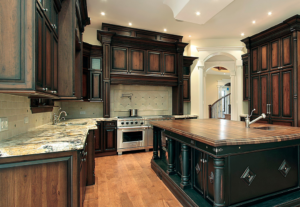
Congratulations on deciding to make a long-term investment for your home with the purchase of a beautiful granite counter. Granite is both beautiful and strong, ensuring that the investment you make will last your household a lifetime and beyond. If you have never gone through the process of installation before, then there is a couple of things you need to know. This will help smooth the process, so you can enjoy your new granite countertop sooner!
Before The Day Of Installation
Once you have made your appointment for installation, you need to do a few things before the team arrives:
• Clear a path through your home to the job site, whether that is your kitchen, bathroom, basement, or anywhere the granite is being installed. You want to choose the closest entrance, since the team will be carrying in the slabs of granite, and the pathway should limit maneuvering as much as possible.
• Keep small children and pets out of the way for safety.
• Protect any nearby furniture or textiles from dust by covering them up.
• Clear the countertops in your home of objects to make sure they are ready for removal, if necessary. Try to limit obstacles around the workspace.
• If you have other contractors and artisans working on other projects, especially during a new home construction, then you should have them clear the area momentarily while the stone slabs are being transported to the job site.
• You have to be present during the installation procedure. Our team is going to go over the steps of installation and will need approval before finishing the installation.
During The Installation
Because your satisfaction is our main concern, we would like for you to be present during the installation. Please feel free to ask any questions before the procedure begins. Once the job commences, you don’t have to remain physically present. We need to concentrate on the job at hand and focus on the strategy for installing your new granite counters.
You are welcome to watch, but the craftsmen often prefer to work without interruptions once they begin.
Removing Existing Counters
In the event that your household has existing countertops, it is often required those units are removed prior to the installation team’s arrival. However, you may also request to have the existing countertops removed at the same time the new granite countertops are being installed. The team will work to avoid damaging other sections of the job site, including cabinets, walls, and so on. Should you have laminate counters with a backsplash, the wall plaster could come off; but you don’t need to worry about that, since the granite countertop will cover up those blemishes.
Cabinets, Putting Everything Into Place, and More
Next, the team starts to work in steps, including the following:
Level Cabinets
The crew will check that the cabinets are level, since granite needs to be secured. If the granite is being placed on a freestanding island, the cabinets must be anchored to the floor. Since there is a tipping hazard, level cabinets are absolutely essential.
But what happens if the cabinets are not level? Sometimes, shims can be placed under the granite countertop to make up for any discrepancies, but if that remedy doesn’t apply, a contractor will have to be called in to adjust the level of the cabinets.
It is recommended to check the level of your cabinets beforehand if you believe that there could be an issue. This would prevent any mishaps and last minute surprises.
Seams and Caulking
With the level of the cabinets assessed, the team then moves onto the actual installation of the granite countertop. The installation crew will lay the granite pieces out then use an epoxy glue that creates seams that will cement sections of granite, soapstone, quartz, and marble together, forming the unified countertop.
You may notice that two kinds of epoxy are used—a clear glue and a neutral one. Depending on the color of the countertop, one epoxy might be used more often than the other. This is so the seams blend in. When the seams had dried, the excess is carefully scraped off with a razor blade to make the seam as smooth and unnoticeable as possible.
Afterwards, the granite is secured to the cabinetry with something called attachment or bondo blocks. After that, you don’t need to worry about the counter moving.
Backsplash, Sinks, and Cooktop Cutouts
Other elements that need to be installed alongside the countertop include the undermount sink, cooktop cutout, and the blacksplash, if you decided that you wanted one. These elements often require minor on-the-spot adjustments to ensure that everything fits correctly. Some pieces will be a tight fight, so you might notice some of the team cutting holes slightly bigger to meet the necessary measurements of any appliances.
Keep in mind that transporting stone with holes already in the material can be risky and cause weakening. Therefore, the craftsmen often create little notches of where to cut. Upon installation, the team finishes the cuts.
A shop vacuum is used to clean up the dust. Everything is then wiped down with acetone or alcohol, removing epoxy that may have been missed, and the job site will be cleaned up as much as possible prior to the team’s leave.
Conclusion
Depending on the size of the counter being installed, the entire installation process can take up 7 hours, but that is the most complex scenario. On average, installation takes around 3 hours from start to finish. Once everything is done, the team will wrap up the day by giving you some maintenance instructions and a review of the job. If you are satisfied, you can start enjoying your beautiful new granite counter right away.
If you are ready to learn more about granite countertops or would like to request information and a hassle-free quote, fill out the contact form. Our knowledgeable staff is on standby and will send more information straight to your inbox.






